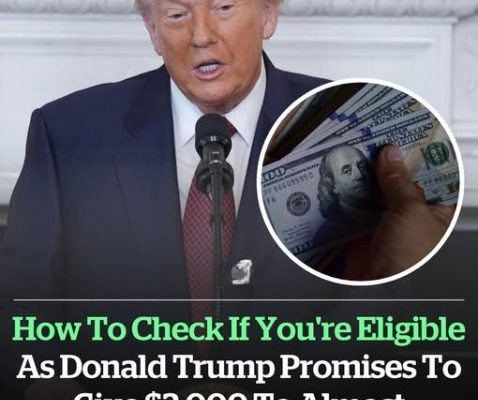Donald Trump has once again set off a political firestorm with a headline-grabbing promise — a $2,000 payment to “almost everyone in America.” In a series of early-morning Truth Social posts, the former president tied his sweeping tariff agenda to what he described as a “dividend” for ordinary Americans. The message was simple: higher tariffs mean more government revenue, and that money, Trump claimed, would flow directly back to the people.
According to his post, “A dividend of at least $2,000 a person (not including high-income people!) will be paid to everyone.” What he didn’t mention were the details that make such a promise possible — or perhaps impossible. There was no explanation of when payments might begin, what counted as “high income,” or how the payouts would be structured.
Still, the message landed like a political thunderclap. For Trump’s supporters, it was another sign that he sees himself as a champion of working Americans. For critics, it was a familiar blend of big talk and murky math.
Tariffs as a Cash Machine
Trump framed his plan as a win-win strategy: tariffs would bring in billions, strengthen U.S. manufacturing, and generate enough surplus to send money directly to citizens. On Truth Social, he wrote, “People that are against tariffs are FOOLS! We are now the richest, most respected country in the world, with almost no inflation, and a record stock market. 401k’s are highest EVER.”
He went on to boast that the U.S. is “taking in trillions of dollars” from tariffs and will “soon begin paying down our ENORMOUS DEBT, $37 trillion.” He also claimed that “record investment” is flowing into new American plants and factories.
The logic is straightforward on the surface: by taxing imported goods, the government collects revenue that could, theoretically, be redistributed to the public. Trump’s posts suggested this money could fund a national payout — a kind of populist dividend funded by foreign trade penalties.
But there’s a catch. The U.S. doesn’t currently take in anything close to the trillions Trump described. Government data shows customs duties generated about $195 billion in the first three quarters of 2025 — a large sum, but nowhere near enough to cover a mass $2,000 payout.
The Numbers Don’t Add Up
Independent economists quickly ran the math and found huge gaps between Trump’s rhetoric and reality.
Erica York, an economist at the Tax Foundation, noted that if the $2,000 checks were limited to Americans earning under $100,000, about 150 million adults might qualify. That would cost roughly $300 billion. If the program included children or broader eligibility, the total could exceed $500 billion.
In comparison, even the most aggressive estimates of tariff revenue fall short by hundreds of billions. “Tariffs have raised $90 billion of net revenues compared to Trump’s proposed $300 billion rebate,” York explained.
Arnold Ventures’ co-chair offered an even starker estimate, pegging the potential cost at $513 billion — more than double what tariffs have brought in so far this year.
In short, the math doesn’t work. Tariffs might raise money, but not enough to fund a universal or near-universal payout.
Legal Hurdles and the Supreme Court Factor
Beyond economics, Trump’s proposal faces serious legal challenges. His entire tariff framework hinges on broad powers granted under the International Emergency Economic Powers Act (IEEPA) — a Cold War-era law meant for emergencies involving national security.
Several courts have already ruled that Trump’s use of IEEPA to justify sweeping tariffs exceeds presidential authority. The Supreme Court recently heard arguments in cases that could decide whether future presidents can unilaterally impose such tariffs.
If the high court sides against him, the revenue base for his $2,000 plan could disappear overnight. Without the legal foundation for broad tariffs, the money simply wouldn’t exist.
Trump, unsurprisingly, has been vocal about this. “The President of the United States is allowed (and fully approved by Congress!) to stop ALL TRADE with a foreign country… but is not allowed to put a simple tariff on a foreign country, even for purposes of NATIONAL SECURITY?” he wrote, blasting the judiciary. “That is NOT what our great Founders had in mind!”
His post continued in characteristic style: “Businesses are pouring into the USA ONLY BECAUSE OF TARIFFS. HAS THE UNITED STATES SUPREME COURT NOT BEEN TOLD THIS??? WHAT THE HELL IS GOING ON???”
Populism Meets Policy
At its core, Trump’s $2,000 pledge is classic populism: a big, simple promise that resonates with voters frustrated by inflation, inequality, and political gridlock. The notion of turning tariff revenue into direct payments echoes stimulus checks during the COVID-19 pandemic — something many Americans still remember fondly.
But while stimulus checks were backed by congressional appropriations, Trump’s new idea depends on executive-driven tariff revenue — a volatile and uncertain source of funds. Economists warn that tariffs often function like hidden taxes, raising prices for consumers and businesses alike.
Put differently, Americans would effectively pay for their own “payout” through higher prices on imported goods.
Still, Trump’s framing — that tariffs punish foreign competitors while rewarding American workers — remains politically potent. It aligns with his America First message and appeals to voters skeptical of globalization.
The Political Calculation
Trump’s timing is no accident. As the 2026 election cycle looms, economic populism has returned as a central campaign theme. The $2,000 promise, even if unrealistic, reinforces his image as a fighter for the average citizen.
By tying the idea to tariffs, Trump also shifts the narrative from tax cuts for the wealthy to benefits for everyday Americans. Whether the money ever arrives is almost secondary; the message itself energizes his base and keeps the spotlight on his trade agenda.
But critics see a different picture — one of fiscal fantasy and legal overreach. The U.S. Treasury cannot simply redirect customs revenue into personal payouts without congressional authorization. Even if it could, diverting that money would create gaps in the budget for programs that already depend on those funds.
So What’s Next?
As of now, the “$2,000 dividend” remains a campaign-style promise without legal or financial grounding. Analysts expect no actual payments in the near term. Even Trump’s allies admit that such a plan would require new legislation, clearer eligibility rules, and an approved funding mechanism.
In reality, the former president’s posts are less about policy rollout and more about narrative control — reframing tariffs as a tool not just for protectionism, but for populist redistribution.
Whether the idea gains traction will depend on two factors: how the Supreme Court rules on tariff authority, and how voters respond to the mix of economic nationalism and personal benefit Trump is selling.
Bottom Line
Trump’s $2,000 payout plan sounds simple: tariffs bring in money, Americans get a check. But beneath the soundbite lies a tangle of fiscal math, legal barriers, and political theater. The promise may stir headlines and fire up his base, but the odds of anyone actually receiving that $2,000 are slim to none — at least for now.
What’s clear is that Trump continues to wield tariffs as both an economic weapon and a political symbol. The question isn’t just whether he can deliver, but whether voters will care about the details — or simply remember the promise.



